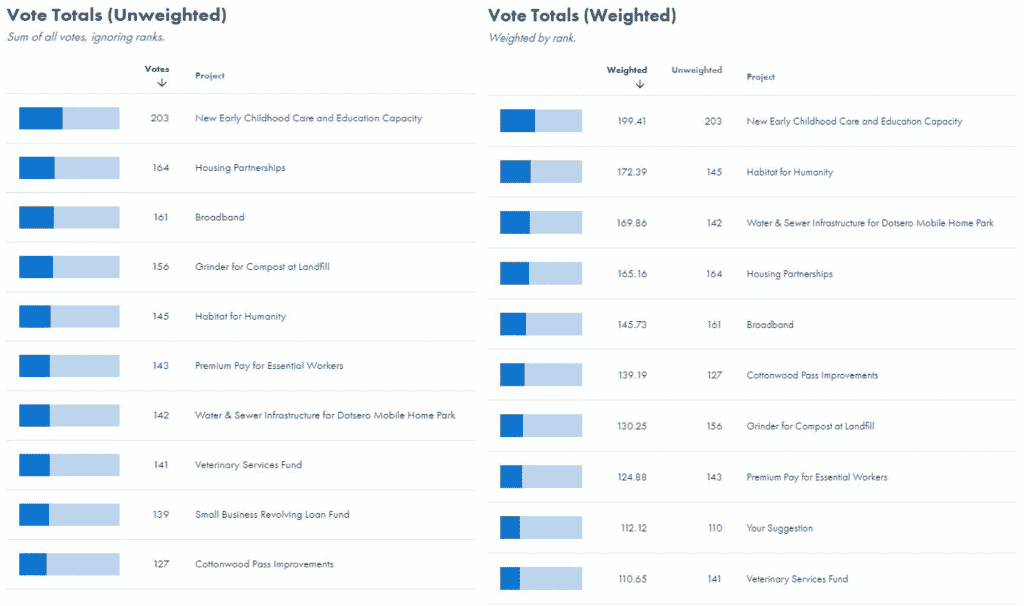Public survey identifies priority uses for COVID-19 recovery funds
Early child care and education capacity, housing partnerships, and Cottonwood Pass upgrades among top priorities for residents

This week, the Eagle County finance department revealed the findings of a public survey that will help determine how $10.7 million of coronavirus recovery funds should be spent. The Coronavirus State and Local Fiscal Recovery Funds program is a part of the American Rescue Plan Act, which is distributing $350 billion to local governments to help rebuild in the aftermath of the pandemic.
Eagle County will receive the funding in full by the end of this summer, and is required to allocate the funds by Dec. 31, 2024, and spend it by Dec. 31, 2026.
The county must put $708,000 toward eligible uses, as determined by guidelines from the federal government, but $10 million is considered revenue replacement and — excluding a few restrictions — can be used in any way that the county sees fit.
Public’s priorities
The public survey was open online from March 3 through April 30 of this year, and received 467 submissions in total. Gypsum, Edwards and Eagle zip codes had the highest number of submissions, and most participants were of working age. The two largest groups of respondents were between the ages of 25 and 44, making up around 50% of the total pool.
In creating the survey, each of the departments in the county were asked to put forth project ideas and pricing estimates, which were then compiled into a list of 19 options. Participants were able to select priorities that altogether added up to $10.7 million dollars or less, and then rank them according to preference.

Support Local Journalism

Eagle County/Courtesy photo
The No. 1 priority that emerged in the survey was “New Early Childhood Care and Education Capacity.” This category received the most overall votes, with 203, and the most high-weighted votes, meaning it was placed up at the top of the list for most people.
Housing partnerships, increasing building capacity for Habitat for Humanity and broadband were all in the top five for overall and weighted votes. According to the survey, these are the four projects that the majority of residents agree on as priorities.
The comparison of weighted and unweighted rankings also provides insight into which projects are a high priority for a smaller group of people. While “Water & Sewer Infrastructure for Dotsero Mobile Home Park” is ranked seventh for overall votes, with 142, it is No. 3 on the weighted list, meaning that those who voted for this project tended to place it at the top of their list.
Cottonwood Pass Improvements received a similar response, ranking 10th on overall votes with 127 but sixth in weighted votes.
On the opposite side of the spectrum, 156 people voted for “Grinder for Compost at Landfill,” but it was ranked seventh in weighted votes as it was lower on the list for most participants.
The “Your Suggestion” category also made it into the weighted top 10, a category that includes a few dozen additional project ideas not originally on the voting docket. “Mountain Tots” was written in 23 times — underlining the importance of early child care education to the community — and “Miller Ranch lighting” was written in 11 times.
In general, the same projects showed up in the top 10 weighted and unweighted categories, showing a clear preference for these projects over the bottom nine.
Next steps
With this information in hand, the finance team is now going back to the departments that submitted top-10 project ideas to ask for formal proposals. The timeline for generating these proposals will be varied depending on the complexity of the project, and the county’s chief financial officer Jill Klosterman said that she anticipates a rolling process for reviewing proposals and allocating the funds.
Klosterman also emphasized the fact that the county is not limited to spending $10.7 million on these high priority projects, and can leverage the funding to have a broader impact. The county also expects to receive more relief funds from the American Rescue Plan Act, which can support additional projects down the line.
“We’re not going to be able to fund all of the top-10 projects with this $10.7 million, but by getting more information, we may be able to find other sources from which we can fund them,” Klosterman said.
The public is invited to weigh in on the developed project proposals when they come in front of the county commissioners in the late summer and fall of this year. While the survey has been a useful tool for narrowing priority actions, which align closely with the commissioners’ priorities, the process will continue to benefit from community input.
“As I do with any budget-related things, I always ask them to think about not just the project or program in front of them, but also what’s the whole financial picture, so that will certainly be a part of any future consideration,” Klosterman said.











